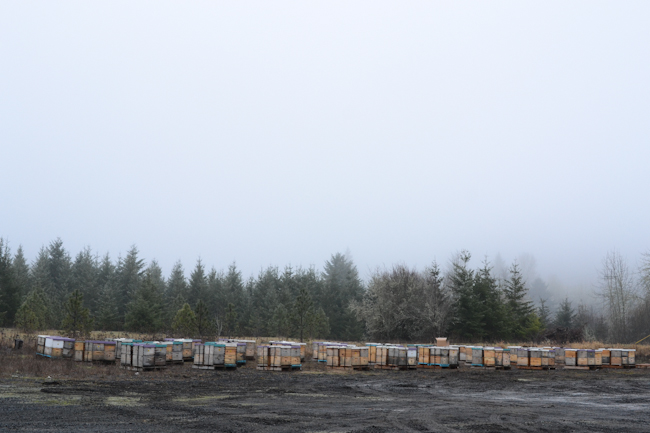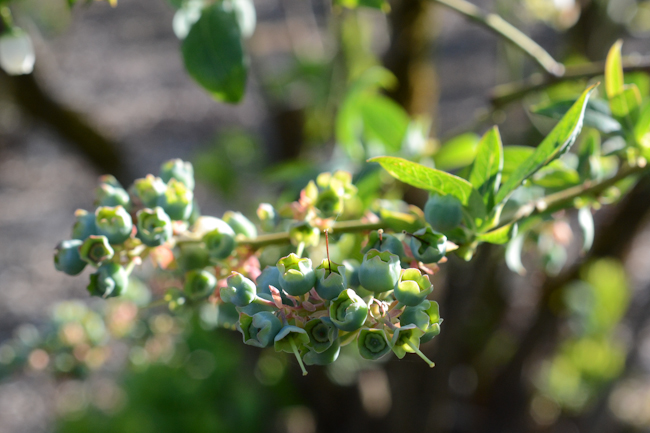Grafting Honeybee Queens

For the last four years, Henry has been adding to and selecting from his pool of honeybee genetics all originating from feral, Pacific Northwest-adapted colonies. In order to propagate those genetics as well as maintain and increase his hive numbers, he started grafting his own queens last year. Grafting queens takes a lot of time, effort, skill, and bees, so it’s not really an activity for hobby beekeepers. There are many other methods of creating new hives that work well on a smaller scale.
Freeze Brood Hygienic Testing of Honeybees

American foulbrood is a bacterial disease that has plagued domestic and feral honeybees around the world for centuries. Infected larvae die off and then begin to rot in the capped cells, and the disease spreads quickly within the hive and then to surrounding hives. Many beekeepers preemptively treat their bees with antibiotics and other chemicals to suppress American foulbrood, but those treatments can also have negative health effects on bees by messing with their digestive systems and making them more susceptible to other diseases. Treatments never completely cure American foulbrood, and bacteria can persist in the hives for a very long time. If beekeepers ever stop treating infected hives, the disease will roar back with devastating consequences for the whole apiary.
Some honeybee colonies can fight off American foulbrood infections on their own. In such cases, the disease will kill off some larvae, but workers will move in quickly to clean out the cells and cannibalize the dead larvae, reducing or eliminating the hive’s exposure to the disease. In that manner, the super organism can survive. This is called “hygienic” behavior and is a desirable trait for domestic honeybees.
The Bees Are Back In Town

Henry’s bees are finally home again after more than two months in California. (More about preparing them for almond pollination here and here.) Henry’s beekeeper/truck driver friend hauled them back north on Sunday, and Henry unloaded them in a local holding yard. Overall, they look really really good. Henry spent most of the day on Monday and Tuesday working his bees, taking necessary steps to prevent the robust colonies from swarming by pulling frames of brood and shaking out bees into nuc (pronounced “nuke”) boxes to form new colonies.
In the last few years or even the last few months, you’ve probably heard about the troubles plaguing the both commercial beekeeping and hobby beekeeping alike. Many of the dire statistics and stories behind them are true, but some of the explanations are grossly oversimplified. We’ve gotten a lot of questions lately about the health of Henry’s bees. While he has had some managed losses, most of his hives are not only surviving but thriving without using any chemical treatments or miticides for three years. Regular miticide applications are a practice that is standard for the vast majority of commercial beekeepers.
The holding yard on private property where the bees were dropped off is ideal because it’s easily accessible with a large truck, and it’s right off the highway. The problem is that, for a brief time at least, there are more bees in one area than the surrounding environment and resources can support, so the bees are having to compete for food and are under extra stress. Except for short transition periods, Henry never keeps more than 24 hives in one yard.
As he finishes working the bees, he’s been dispersing the pallets of hives to nine different smaller yards and pollination areas (1-40 hives each) in Benton and Lincoln Counties. By the end of the weekend, they’ll all be in place to take advantage of spring nectar and pollen flows including maple, madrone, trailing blackberry, poison-oak, etc.
Transporting Bees Locally and to California for Almond Pollination
For most of the year, Henry maintains apiaries of 20 to 30 hives in relatively remote locations in the Coast Range. He decides on ecologically appropriate numbers for each yard by assessing the nectar and pollen resources available at any given time, and he’s careful not to exceed the carrying capacity of the area, especially late in the season. Keeping bees in such low to moderate-density clusters allows bees to fulfill their needs with natural forage (plus seasonal supplements) and discourages robbing. Because Henry is breeding his own lines of bees, he also tries to keep virgin queens away from other people’s maintained hives, so he can incorporate genetics of local, feral-derived bees into his managed colonies.
There are downsides to keeping hives in remote locations. The travel times and fuel expenses associated with maintaining hives in far-flung areas are much greater than keeping larger groups of bees closer to home. There are bears and yahoos out in the boonies that might mess with hives. The roads are rougher and often less accessible, increasing the amount of loading and unloading that must be done by hand. (Each hive weighs about 100 pounds and must be lifted using a crazy amount of finger muscles onto a truck bed that’s 43 inches high.)
In contrast, there are resident beekeepers in parts of the Central Valley in California who keep yards of up to 120 hives. The only way to sustain these hives is by feeding corn syrup and pollen supplements in place of natural flows almost year round. This approach to beekeeping is super cost intensive, and hives in this situation are never able to store honey, let alone produce enough for the beekeepers to harvest any substantial quantity. It’s kind of the cattle feedlot equivalent in beekeeping.
Stimulating Honeybees for 2014 Almond Pollination

In late summer when many humans are beginning to reap the bounty of their gardens and to make plans for the harvest season, honeybee colonies already have their honey stores tucked away, and they’re starting to shut down in preparation for the winter. In September, workers will still have access to pollen, but the nectar flow will wane to a trickle. It will be time for a productive queen to lay the eggs for the colony’s overwintering population. After new brood emerges in October, the busy season’s workers will die off, and the young bees will start to cluster up during cooler weather.
Because Henry knew he was going to take all his full-size hives to California for almond pollination, he, like other commercial beekeepers, stimulated his bees from late summer into fall to increase the number of overwintering bees in each hive. He offered each colony three to four gallons of sugar syrup and five pounds of pollen substitute in three feedings to simulate a nectar flow and allow the bees to rear more brood when natural resources were scarce.
Old Blue Raw Honey Sampling Event in Portland
You should listen to this clip from The Splendid Table in which Marina Marchese makes a case for buying honey directly from beekeepers. It’s a little highbrow and maybe not quite 100% technically accurate, but it covers pretty much everything Henry and I have been saying (and doing) for a while.
This is an event for sampling our honey, tasting our oranges, admiring our cutting boards, and chatting about homestead activities. Come see us, eh?
If you need a reminder or want us to know that you’ll be there, you can RSVP via Facebook here.
Honey Extraction at Honey Tree Apiaries
It’s honey harvest time around these parts. In the Oregon Coast Range where Henry (doing business under the name Old Blue) has his remote apiaries, the nectar flow has pretty much dried up to a trickle even though there’s still plenty of pollen to be had. Henry is now working on preparing hives for the long winter by equalizing colonies, requeening if necessary, and beginning to feed syrup and pollen substitute. Most other commercial beekeepers are treating for mites right now, but Henry has chosen to manage his hives without standard miticide applications for the third season in a row. Without pesticides, there is more at stake, but Henry feels that natural mite loads put selection pressure on his colonies, and the resulting survivors express resistant traits reflected in the wild bee population.
This year, Henry worked hard to increase his number of hives by splitting stronger colonies, grafting queens, doing removals, and catching swarms, so honey production was not his primary focus. He also planned on leaving 60-70 pounds of honey in each full-size hive, more than the recommended 40-60 pounds, which should translate to a stronger colony buildup in the spring of 2014.
Pollination at Radke's Blueberries
This spring, Henry agreed to pollinate at Radke’s Blueberries, hands down the best U-pick blueberry farm in the Corvallis area if not the entire world (read more about the place here). Blueberry growers generally contract with beekeepers to drop off two or more hives per acre during bloom time. Having honeybees on hand ensures widespread pollination and a good fruit set.
Bumblebees are highly effective blueberry pollinators, even better than honeybees, but commercial blueberry farms often have large fields with only bits of bumblebee habitat around the fringes, and that scale limits the reach of bumblebee foragers and increases the need to bring in honeybees. Radke’s Blueberries, however, in not a particularly big operation, less than ten acres, and Ed Radke is keenly aware of the local bumblebee population, realizing their value as pollinators.
Honeybee Removal Season
As things warm up around here, Henry’s been starting to schedule 2013 honeybee extractions. (I’m using the term “honeybee extraction” in this post to mean the act of removing unwanted honeybees that are living on their own in people’s barns, garages, rotten trees, etc.) The next month and a half or so is the best time of year (as opposed to summer) for doing extractions for several reasons: colonies are smaller with fewer bees and less brood to have to worry about rehiving, the bees will have longer to recover and establish strong hives over the summer, less nectar in the hives means the process will be less messy and fewer bees will be drenched and mashed in the process, and newly boxed colonies are less likely to get their honey stores robbed by other bees this early in the season. Spring bee removals are more convenient and cheaper for homeowners as well because Henry can usually get the job done in one or two sessions (as opposed to multiple sessions in the summer), which keeps his costs down and therefore keeps his fees down, too.
Through word of mouth, Henry heard about an old barn in the Blodgett area that had at least one colony of bees living in the wall. He approached the landowner (Mike from Willamette Saw Service) and asked if he wanted the bees gone. Mike agreed, so Henry made a quick visit to the site last week to scope it out.
Comb

Honeybee’s comb is about the coolest stuff ever. It’s beautiful, functional, symmetrical, and it smells good to boot. Comb is also a wonderfully multipurpose substance. It provides structure for a hive, the right nooks and conditions for rearing brood, and storage space for pollen and of course, honey.
Bees have four pairs of glands on their abdomen that secrete wax flakes that young bees pick off, chew up, and mold into comb. The color of new comb depends on current nectar sources, the race of honeybees in the hive, how much/what type of pollen they’re collecting, and other factors, but new comb is typically white, though in some cases, bees can make bright yellow comb. As the same comb is used over and over, it will darken in color.





